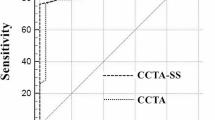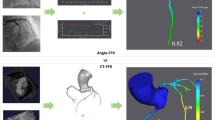Abstract
Purpose
Coronary angiography is the “gold standard” for diagnosing coronary artery disease. At present, the methods for detecting and evaluating coronary artery stenosis cannot satisfy the clinical needs, e.g., there is no prior study of detecting stenoses in prespecified vessel segments, which is necessary in clinical practice.
Methods
Two vascular stenosis detection methods are proposed to assist the diagnosis. The first one is an automatic method, which can automatically extract the entire coronary artery tree and mark all the possible stenoses. The second one is an interactive method. With this method, the user can choose any vessel segment to do further analysis of its stenoses.
Results
Experiments show that the proposed methods are robust for angiograms with various vessel structures. The precision, sensitivity, and \(F_1\) score of the automatic stenosis detection method are 0.821, 0.757, and 0.788, respectively. Further investigation proves that the interactive method can provide a more precise outcome of stenosis detection, and our quantitative analysis is closer to reality.
Conclusion
The proposed automatic method and interactive method are effective and can complement each other in clinical practice. The first method can be used for preliminary screening, and the second method can be used for further quantitative analysis. We believe the proposed solution is more suitable for the clinical diagnosis of CAD.










Similar content being viewed by others
Data Availibility Statement
The used data are available upon request from Qing Zhang.
Code Availability Statement
Private code repository.
References
Husmann L, Leschka S, Desbiolles L, Schepis T, Gaemperli O, Seifert B, Cattin P, Frauenfelder T, Flohr TG, Marincek B, Kaufmann PA, Alkadhi H (2007) Coronary Artery Motion and Cardiac Phases: Dependency on Heart Rate-Implications for CT Image Reconstruction. Radiology 245(2):567–576
Roth GA, Abate D, Abate K, Hassen A, Solomon M, Abbafati C, Abbasi N, Abbastabar H, Abd-Allah F, Abdela J, Abdelalim A et al (2018) Global, regional, and national age-sex-specific mortality for 282 causes of death in 195 countries and territories, 1980–2017: a systematic analysis for the global burden of disease study 2017. Lancet 392(10159):1736–1788
Virani SS, Alonso A, Benjamin EJ, Bittencourt MS, Callaway CW, Carson AP, Chamberlain AM, Chang AR, Cheng S, Delling FN et al (2020) Heart disease and stroke statistics-2020 update: a report from the american heart association. Circulation 141(9):e139–e596
Song J, Zheng Z, Wang W, Song Y, Huang J, Wang H, Zhao H, Hu S (2013) Assessment of Coronary Artery Stenosis by Coronary Angiography: A Head-to-Head Comparison With Pathological Coronary Artery Anatomy. Circ Cardiovasc Interv 6(3):262–268
Makowski P, Sørensen TS, Therkildsen SV, Materka A, Stødkilde-Jørgensen H, Pedersen EM (2002) Two-phase active contour method for semiautomatic segmentation of the heart and blood vessels from mri images for 3d visualization. Comput Med Imaging Graph 26(1):9–17
Carrillo JF, Hoyos MH, Dávila EE, Orkisz M (2007) Recursive tracking of vascular tree axes in 3d medical images. Int J Comput Assist Radiol Surg 1(6):331–339
Manniesing R, Viergever MA, Niessen WJ (2007) Vessel axis tracking using topology constrained surface evolution. IEEE Trans Med Imaging 26(3):309–316
Xiao R, Yang J, Goyal M, Liu Y, Wang Y (2013) Automatic Vasculature Identification in Coronary Angiograms by Adaptive Geometrical Tracking. Comput Math Methods Med 1–11:2013
Frangi AF, Niessen WJ, Vincken KL, Viergever MA (1998) Multiscale vessel enhancement filtering. In: Wells WM, Colchester A, Delp S (eds) Medical image computing and computer-assisted intervention–MICCAI’98. Lecture Notes in Computer Science. Springer Berlin Heidelberg, Berlin, pp 130–137
Cruz-Aceves I, Cervantes-Sanchez F, Avila-Garcia Maria S (2018) A novel multiscale Gaussian-matched filter using neural networks for the segmentation of x-ray coronary angiograms. J Healthc Eng
Jo K, Kweon J, Kim Y-H, Choi J (2018) Segmentation of the main vessel of the left anterior descending artery using selective feature mapping in coronary angiography. IEEE Access 7:919–930
Fang H, Zhu J, Ai D, Huang Y, Jiang Y, Song H, Wang Y, Yang J (2019) Greedy soft matching for vascular tracking of coronary angiographic image sequences. IEEE Trans Circuits Syst Video Technol 30(5):1466–1480
Xian Z, Wang X, Yan S, Yang D, Chen J, Peng C (2020) Main coronary vessel segmentation using deep learning in smart medical. Math Probl Eng
Nasr-Esfahani E, Karimi N, Jafari MH, Soroushmehr SMR, Samavi S, Nallamothu BK, Najarian K (2018) Segmentation of vessels in angiograms using convolutional neural networks. Biomed Signal Process Control 40:240–251
Danilov VV, Klyshnikov KY, Gerget OM, Kutikhin AG, Ganyukov VI, Frangi AF, Ovcharenko EA (2021) Real-time coronary artery stenosis detection based on modern neural networks. Sci Rep 11(1):7582
Fu H, Xu Y, Lin S, Wong DWK, Liu J (2016) Deepvessel: retinal vessel segmentation via deep learning and conditional random field. In: International conference on medical image computing and computer-assisted intervention. Springer, pp 132–139
Yan Z, Yang X, Cheng K-T (2018) A three-stage deep learning model for accurate retinal vessel segmentation. IEEE J Biomed Health Inform 23(4):1427–1436
Oliveira A, Pereira S, Silva CA (2018) Retinal vessel segmentation based on fully convolutional neural networks. Expert Syst Appl 112:229–242
Jin Q, Meng Z, Pham TD, Chen Q, Wei L, Su R (2019) Dunet: a deformable network for retinal vessel segmentation. Knowl-Based Syst 178:149–162
Wu Y, Xia Y, Song Y, Zhang Y, Cai W (2020) Nfn+: a novel network followed network for retinal vessel segmentation. Neural Netw 126:153–162
Wang D, Haytham A, Pottenburgh J, Saeedi O, Tao Y (2020) Hard attention net for automatic retinal vessel segmentation. IEEE J Biomed Health Inform 24(12):3384–3396
Chen C, Chuah JH, Raza A, Wang Y (2021) Retinal vessel segmentation using deep learning: a review. IEEE Access
Cong C, Kato Y, Vasconcellos HD, Lima J, Venkatesh B (2019) Automated stenosis detection and classification in x-ray angiography using deep neural network. In: 2019 IEEE international conference on bioinformatics and biomedicine (BIBM). IEEE, pp 1301–1308
Ovalle-Magallanes E, Avina-Cervantes JG, Cruz-Aceves I, Ruiz-Pinales J (2020) Transfer learning for stenosis detection in x-ray coronary angiography. Mathematics 8(9):1510
Rudin LI, Osher S, Fatemi E (1992) Nonlinear total variation based noise removal algorithms. Physica D 60(1–4):259–268
Malin DF (1977) Unsharp masking. AAS Photo Bull 16:10–13
Ericksen JP, Yankaskas BC, Muller KE, Pizer SM, Johnston RE (1990) Contrast-limited adaptive histogram equalization: speed and effectiveness. In: [1990] Proceedings of the first conference on visualization in biomedical computing, pp 337–345
Khan MA, Chen W, Ullah A, Fu Z (2017) A mesh-free algorithm for ROF model. EURASIP J Adv Signal Process 2017(1):53
Deng G (2017) A generalized unsharp masking algorithm. IEEE Trans Image Process 20(5):1249–1261
Setiawan AW, Mengko TR, Santoso OS, Suksmono AB (2013) Color retinal image enhancement using CLAHE. In: International conference on ICT for smart society, pp 1–3
Vese LA, Chan TF (2001) Active contours without edges. IEEE Trans Image Process 10(2):266–277
Tian Y, Chen Q, Wang W, Peng Y, Wang Q, Duan F, Wu Z, Zhou M (2014) A vessel active contour model for vascular segmentation. BioMed Res Int 2014:106490
Neubauer AM, Garcia JA, Messenger JC, Hansis E, Kim MS, Klein AJP, Schoonenberg GAF, Grass M, Carroll JD (2010) Clinical feasibility of a fully automated 3d reconstruction of rotational coronary x-ray angiograms. Circul Cardiovasc Interv 3(1):71–79
Funding
Yaofang Liu, Xinyue Zhang, Wenlong Wan, Shaoyu Liu, Yingdi Liu, Hu Liu, and Xueying Zeng were supported by the National Natural Science Foundation of China [Nos. 11771408, 11871444] and the Fundamental Research Funds for the Central Universities [No. 201964006]. Qing Zhang was supported by the National Natural Science Foundation of China [No. 81671703], the Key Fund of Department of Cardiology, Shandong University Qilu Hospital (Qingdao) [QDKY2019ZD04], the Key Research and Development Project of Shandong Province [No. 2015GSF118026], the Qingdao Key Health Discipline Development Fund, and People’s Livelihood Science and Technology Project of Qingdao [No. 18-6-1-62-nsh].
Author information
Authors and Affiliations
Contributions
Yaofang Liu, Xinyue Zhang, and Wenlong Wan contributed equally.
Ethics declarations
Conflict of interest
Authors do not have any conflicts of interest.
Ethical approval
This article does not contain any studies with human participants or animals performed by any of the authors.
Informed consent
Not applicable.
Additional information
Publisher's Note
Springer Nature remains neutral with regard to jurisdictional claims in published maps and institutional affiliations.
Rights and permissions
About this article
Cite this article
Liu, Y., Zhang, X., Wan, W. et al. Two new stenosis detection methods of coronary angiograms. Int J CARS 17, 521–530 (2022). https://doi.org/10.1007/s11548-021-02551-6
Received:
Accepted:
Published:
Issue Date:
DOI: https://doi.org/10.1007/s11548-021-02551-6




